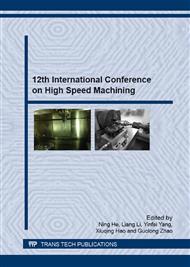[1]
A Tricoteaux, P.Y. Jouan, J.D. Guerin, J Martinez, A Djoudai, Fretting wear properties of CrN and Cr2N coatings, Surface and Coatings Technology, 2003, 174-175: 440-443.
DOI: 10.1016/s0257-8972(03)00597-8
Google Scholar
[2]
T Polar, T Kubart, R Novak, L Kopecky, P Siroky, Comparison of tribological behavior of TiN, TiCN and CrN at elevated temperatures, Surface and Coatings Technology, 2005, 193(1-3); 192-199.
DOI: 10.1016/j.surfcoat.2004.07.098
Google Scholar
[3]
H.Y. Chen, F.H. Lu, Oxidation behavior of chromium nitride films, Thin Solid Films, 2006, 515(4): 2179-2184.
DOI: 10.1016/j.tsf.2006.06.039
Google Scholar
[4]
W Tillmann, E Vogli, S Mohapatra, A new approach to improve SCC resistance of austenitic stainless steel with a thin CrN film, deposited by cathodic vacuum arc deposition technique, Surface and Coatings Technology, 2007, 202(4-7): 750-754.
DOI: 10.1016/j.surfcoat.2007.07.020
Google Scholar
[5]
S. k. Pradhan, C Nouveau, A Vasin, M.A. Djouadi, Depositon of CrN coatings by PVD methods for mechanical applicantion, Surface and Coatings Technology, 2005, 200(1-4): 141-145.
DOI: 10.1016/j.surfcoat.2005.02.038
Google Scholar
[6]
V Kouznetsov, K Macák, J.M. Schneider, et al, A novel pulsed magnetron sputter technique utilizing very high target power densities, Surface and Coatings Technology, 1999, 122: 290–293.
DOI: 10.1016/s0257-8972(99)00292-3
Google Scholar
[7]
J Bohlmark, J.T. Gudmundsson, J Alami, et al, Spatial electron density distribution in a high-power pulsed magnetron discharge, IEEE Transactions on Plasma Science, 2005, 33(2): 346 - 347.
DOI: 10.1109/tps.2005.845022
Google Scholar
[8]
Q.M. Wang, X.B. Zhang, S.H. Zhang, C.Y. Wang, S. H Wu, Progress of high power impulse magnetron sputtering for deposition of hard coatings, Journal of Guangdong University of Technology, 2013, 04: 133.
Google Scholar
[9]
S Konstantinidis, J.P. Dauchot, M Hecq, Titanium oxide thin films deposited by high-power impulse magnetron sputtering, Thin Solid Films, 2006, 515(3): 1182–1186.
DOI: 10.1016/j.tsf.2006.07.089
Google Scholar
[10]
G Greczynski, J Jensen, J Bohlmark, et al,. Microstructure control of CrNx Films During High Power Impulse Magnetron Sputtering, Surface and Coatings Technology, 2010, 205: 118.
DOI: 10.1016/j.surfcoat.2010.06.016
Google Scholar
[11]
H.B. Chen, L.Y. Fu, C.F. Luo, The trends of PCB drilling technology, Printed Circuit Information, 2008, 8: P: 34-37.
Google Scholar
[12]
L.Y. Fu, J Wang, C.F. Luo, Key Points to Develop Ultra Small Micro Drill Bit, Printed Circuit Information, 2009(S1).
Google Scholar
[13]
J Lin, Z.L. Wu, X.H. Zhang, et al, A comparative study of CrNx coatings synthesized by Dc and pulsed Dc magnetron sputtering, Thin Solid Films, 2009, 517(6): 1887–1894.
DOI: 10.1016/j.tsf.2008.09.093
Google Scholar
[14]
X.N. Zhang, K. M Chen, Q. F Guan, et al, Effect of pulsed bias on microstructure and mechanical properties of CrN_x coatings deposited by arc ion plating, Journal of Aeronautical Materials, 2010, 30(5): 73-77.
Google Scholar
[15]
W Heinke, A Leyland, A Mathews, G Berg, C Friedrich, E Broszeit, Evaluation of PVD nitride coatings, using impact, scratch and Rockwell-C adhesion tests, Thin Solid Films, 1995, 270: 431-438.
DOI: 10.1016/0040-6090(95)06934-8
Google Scholar
[16]
W Heinke, A Leyland, A Mathews, G Berg, C Friedrich, E Broszeit, Evaluation of PVD nitride coatings, using impact, scratch and Rockwell-C adhesion tests, Thin Solid Films, 1995, 270: 431-438.
DOI: 10.1016/0040-6090(95)06934-8
Google Scholar


